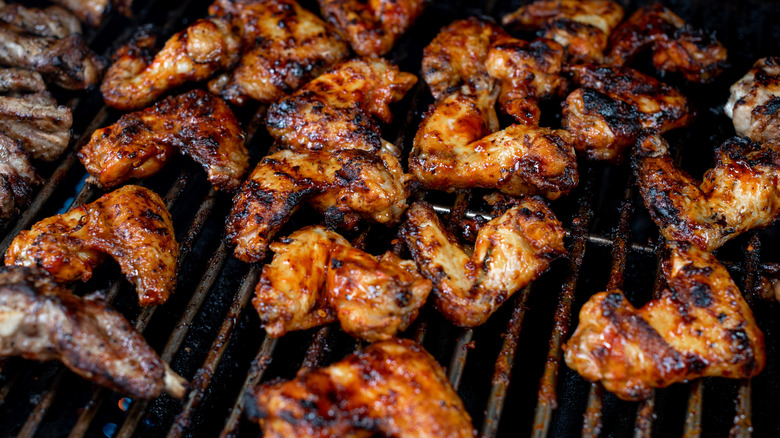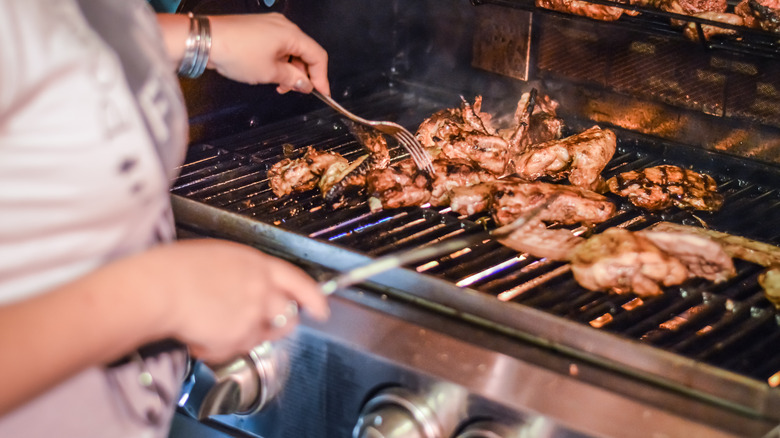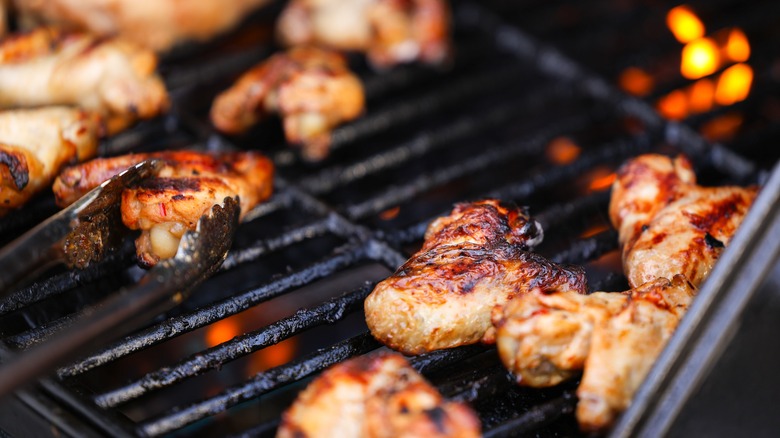Treat Your Gas Grill Like An Oven For The Best Possible Chicken Wings
Grilling up a batch of chicken wings seems like it should be a simple task, right? Just slice 'em up, maybe give those wings a balsamic glaze for some extra flavor, and throw them right on top of the grill until the exterior is etched with beautiful grill marks and the inside is up to temp. Easy!
Well, if you've ever grilled up a batch and they turned out to be bone-dry, chewy hunks of meat, then you'll know the reality is very much different. Flavorful grilled chicken is easy to prep and cook once you know what you're doing, but it's hard to master. While there are tons of tips and tricks developed over the years to help you grill some juicy and succulent wings, arguably the most important is this: You should treat your gas grill like an oven and cook your chicken with indirect heat.
Those mouthwatering photos of chickens sizzling over open flames in your cookbooks may look amazing, but they can trick a lot of people into thinking that they must always keep their chicken wings directly on top of the flame. That's a one-way ticket to getting wings with burnt outsides and raw insides. Instead, if you want them to come off the grate just right, keep the chicken wings off to the side of the flame. As the heat gently wafts over the chicken, it'll slowly cook your birds both outside and in, ensuring they're cooked evenly throughout.
Give your chicken wings the oven treatment
Direct heat, while excellent for creating those coveted grill marks, can quickly overcook the exterior before the inside has a chance to catch up. Imagine the heat here like the flame of a blowtorch. The heat is high and very concentrated, so it has no issue scoring grill marks onto the skin of the wings. That said, it needs a lot of time to penetrate through the skin and deep into the core of the meaty wings. That's time that your wings don't have. By the time the core can be cooked, which can take up to 30 or 40 minutes, the outside has already been overdone.
To cook the wings all the way through, you'll need to rely on indirect heat, which works pretty much like an oven. Keep your chicken wings on the cooler side of the grill and away from the heat source, then close the lid of the grill to let the hot air circulate. The revolving radiating heat — much gentler than the blowtorch-like flame — will waft over and gradually bring the wings up to temperature. Sure, it'll take longer and the wings won't develop much more of a char, but in return, you'll get juicy (and more importantly, fully cooked) wings by the time you're finished.
Direct heat for grill marks, indirect for doneness
Fortunately, you don't have to choose between direct or indirect heat when you grill. Instead, you can get the best of both worlds with a two-zone approach. This method, endorsed by chefs like Bobby Flay, involves setting up two separate cooking zones on your grill. On one side, create direct high heat by turning the gas burner to its maximum setting. The other side, reserved for indirect cooking, should have the burner turned off. It's like having a two-zone fire on a charcoal grill, just that with a gas grill, you can adjust the temperature more easily just by cranking the burners' knobs.
Place the chicken wings on direct heat first and grill for three to five minutes until the pieces have prominent grill marks etched on them. Once you've got that lovely char and the colors are right, pick up the tongs and transfer the wings to the indirect heat side. Here, they'll continue cooking through until the internal temperature reaches a safe 165 degrees Fahrenheit (you can make sure of that with a meat thermometer.) Expect a wait, this may take up to 30 minutes.
Voilà! You now have wings with a deep, smoky flavor from the initial sear, complemented by super tender, moist meat underneath the golden-brown skin. Serve them with a dipping sauce such as a blue cheese dip, and you've got a real crowd-pleaser on your hands.


